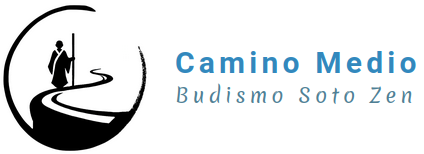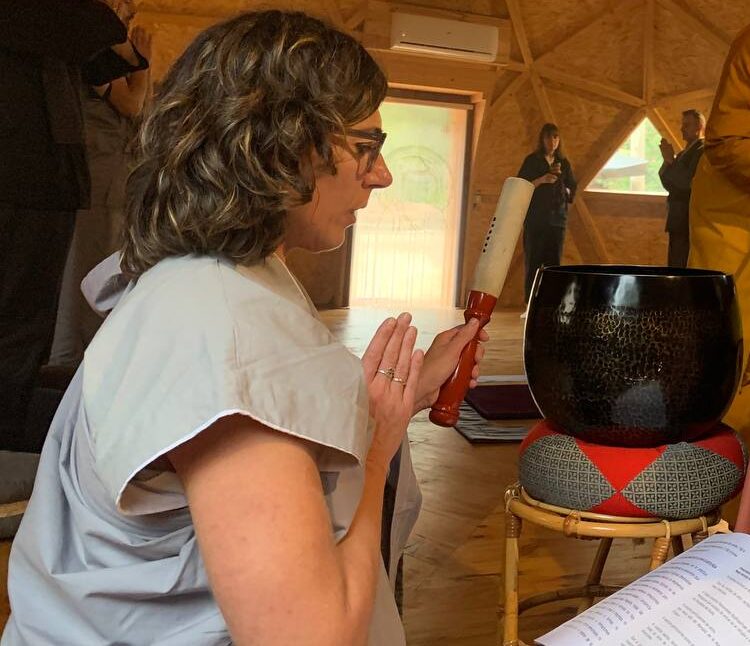⏱️ Estimated reading time: 9 min
The history of Zen Buddhism has been woven, mostly, With male voices. The most cited figures in the transmission texts are men. But on the margins of those official stories, Many women have sustained practice with the same determination, With clarity without ornaments, With a commitment that has rarely been recognized. Not that they did not exist; is that their names were not written with paper on paper.
To understand this invisibility story, It is necessary to go back to the very origins of Buddhism, Where we found that your participation was not just early, but also fundamental for the establishment of tradition.
The foundations: women in the era of the historical Buddha
The presence of women in Buddhism is not a late incorporation or a modern concession, but a constitutive element since the same beginnings of tradition. When Siddhartha Gautama reached lighting and began teaching the Dharma, Women soon recognized in their words a path to liberation that transcended the limitations imposed by the society of their time.
Mahapajapati Gotami: The founder of the monacato
Mahapajapati Gotami, maternal aunt and adoptive mother of the Buddha, She was the first woman to request the ordination directly from Gautama Buddha, thus becoming the first bhikkhuni (Buddhist nun). Its history marks a crucial historical moment: He headed a group of five hundred women in a march to request the foundation of the First Women's Community, being considered therefore the mother of all nuns.
Tradition tells that when Mahapapati initially approached the Buddha with his request, This was reluctant, Not because women unable to achieve lighting, but possibly because of the social complications that such decision could entail in a deeply patriarchal society. However, Mahapapati's perseverance, Who was shaved with shaved and dressed in yellow robe, Together with Ananda's intercession (Buddha Personal Cousin and Assistant), managed to establish the precedent that would open the monastic road to women.
Yasodhara: From wife to Arrahat
Yasodhara, Prince Sidarta's wife before her awakening, represents another fundamental figure in this founding story. Far from being merely “The abandoned woman” how sometimes it presents it, Yasodhara later joined the Bhikkhuni order of Buddhist nuns and it is said that Arhat's state reached, The highest level of spiritual realization in primitive Buddhism.
Its path to lighting offers a unique perspective on practice, Yasodhara developed his understanding of Dharma Through the experience of motherhood, the separation and, finally, The conscious resignation. Its history suggests that paths towards liberation can be diverse and that experiences specifically of women do not constitute obstacles, but valid paths towards deep understanding.
THE VOTIATHA VOICES
He Therigatha, A collection of 73 poems attributed to the first Buddhist nuns, preserves the direct voices of these spiritual pioneers. These verses, considered among the world's oldest texts written by women, They offer intimate testimonies of their experiences of awakening.
Among the figures that emerge from these texts are Kisa Gotami, One of the first disciples of Siddharta Gautama and, According to some traditions, The first Buddhist woman to achieve lighting, being also one of the first to teach the Dharma To others. Its history, marked by the loss of a child and its subsequent understanding of the universality of suffering, illustrates how personal pain experiences can be transformed into compassionate wisdom.
A precedent that was lost
The remarkable thing about this founding period is that women were not only included in the Buddhist community, but they were explicitly recognized the ability to achieve complete realization. The Buddha established that both men and women could achieve total liberation, An unthinkable recognition for his time that contrasted markedly with other contemporary religious traditions.
However, This equal precedent was eroding over time. The ecclesiastical lineage of women was lost centuries ago in most Asian countries, and the institutional structures that developed later tended to completely marginalize or exclude their participation in spiritual leadership roles.
Historical figures in the Zen tradition
The first Chinese teachers
In the Annals of the Chinese Zen we find extraordinary figures that challenge the stereotypes of its time. Zongchi (Seventh century), Princess of the Liang dynasty and daughter of Emperor Wu, He left courtly life to become direct disciple of Bodhidharma, The legendary founder of Zen. ORDERED NIJA TO THE 19 years, It was recognized as one of the four heirs of the Dharma of the first patriarch. Its history reminds us that from the same origins of Zen, Women found in this practice a path of liberation that transcended social limitations.
Moshan Liaoran (siglo IX) represents another fundamental milestone. During the Tang dynasty, It became the first Chinese woman of whom we have historical record as the abbess of a Zen monastery. On Mount Moshan he directed a prosperous community and was recognized for his wisdom. Ancient records preserve some of their meetings with visiting monks, where he responded with the characteristic acuity of the Zen teachers of his time. On a famous occasion, When a young monk arrived at his temple with disdainful air, She asked him: “Have you come to see the dragon or simply play with mud in the pond?”
The Japanese Zen and his teachers
Mugoic (1223-1298), Also known as Chiyono, Mark a turning point in the history of Japanese Zen. First Japanese woman officially recognized as teacher Zen, founded the Kamakura temple in Kamakura. His awakening occurred, according to tradition, When he had water in a bamboo bucket under the full moon. When the bottom of the container breaks, The lunar reflection disappeared, and with him, Any sensation of separation between observer and observed. This moment of lighting led her to compose the verse: “In this way and that I tried to keep the bucket intact, hoping that the fragile bamboo cane will not break. Suddenly, The background broke. No more water, No more moon in the water!”
His lineage was not forgotten. The temple that founded maintained an uninterrupted succession of abbess for centuries, becoming shelter and practice center for women looking for a contemplative life outside of traditional social roles.
Structural challenges: The reasons for silence
The invisibility of women in Zen was not accidental, but result of specific social and religious structures. In China, During Tang and Song dynasties, Although Buddhism enjoyed relative social prestige, women faced restrictions to access the necessary formal education for the written transmission of the Dharma. The texts were compiled in male monasteries, and the oral teachings of the teachers were rarely recorded.
In Japan, The system iemoto (headquarters) of the institutional zen reinforced these exclusions. During the edo period (1603-1868), Zen temples were organized according to strict hierarchies that relegated women to subsidiary temples or completely excluded them from formal training. Many practitioners were forced to maintain their discipline in hiding or within structures that confined them to domestic and service roles.
However, It is important to note that this exclusion was not total. Temples like Yongtai were specifically designed as monasteries for women since the Tang period, And they maintained traditions of practice for centuries. These communities developed their own forms of transmission and teaching, adapted to the particular circumstances of the practitioners.
The contemporary panorama: voices that emerge
Western pioneers
The western zen has seen teachers flourish whose approach has significantly enriched tradition. Charlotte Joko Beck (1917-2011) developed a teaching style that integrated the formal practice of the zazen With Western Psychology and everyday life. His approach focused on “wake up to daily life, Discover the ideal in everyday life”, moving away from the most ritualized aspects of traditional Zen to focus on the practical transformation of ordinary experience.
Toni Packer (1927-2013) carried this demystification even further, questioning even the need for traditional structures such as formal transmission and religious titles. His work at the Springwater Center in New York showed that the essence of Zen practice could remain intact without the institutional ornaments that historically had excluded or limited the participation of women.
Current transformations in the Sanghas
Today we witness deep changes in the Zen communities around the world. In the United States, Europe and Latin America, Many sanghas are implementing more inclusive structures that explicitly recognize the differences in experience between practitioners of different genres, sexual ethnicities and orientations.
Some centers have developed specific practice groups for women as a space for healing and exploration of the particular dimensions that practice can have for those who have lived in contexts of historical discrimination. Others have reviewed their leadership structures to ensure equitable representation in management advice and teaching positions.
In Japan, even within the more traditional institutional zen, changes begin to appear. Some schools have begun to order women on equal foot with men, and historically male temples have opened their doors to practitioners of all genres.
Beyond the categories: Towards an integral practice
There is still a long way to go in our society, But our commitment is to cultivate lucid attention to these aspects, leaving behind the rigid division between women and men to open ourselves to the richness of experiences that manifest in practice. Each human being who sits on the Zafu and accesses its inner world begins to undo the stories that tie it to unconscious identifications. Y, however, We cannot forget that silence springs about a story, A concrete culture and social structure.
Equity is not a political concession added to the Dharma, but a natural manifestation of awakening: I don't appropriate anything, Does not exclude anyone, and recognize in each person a potential without limits. In communities that live this dimension with honesty, Inclusion is not a goal to achieve, but an ethical and spiritual expression of deep interdependence that Buddhism Soto Zen points out as our true nature.
Practicing with gender awareness is not loading practice with ideology, but look clearly. Is to recognize that the past continues to mold the present, that historical structures condition current possibilities, and that an essential part of the path is to consciously transform everything that prevents the free flowering of all beings.
This text is, ultimately, a gesture of recognition towards all invisible teachers who kept the flame of the Dharma In times and places where your voice could not be registered. It is also a call to remember that the history of Zen is much broader than they told us, richer in nuances and perspectives of what traditional texts let us see. Many of those teachers walk today by our side, Maybe without titles or formal lineages, But with a presence that shows us the way in every daily gesture. Because the Dharma, When it is authentic, Always host all voices. Because the awakening has no face, It has no gender, You know no limits.

